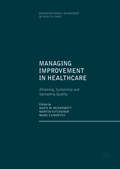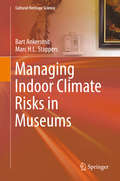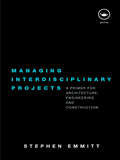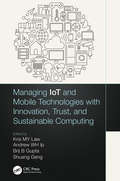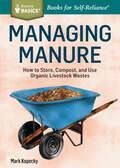- Table View
- List View
Managing Improvement in Healthcare: Attaining, Sustaining and Spreading Quality
by Aoife M. Mcdermott Martin Kitchener Mark ExworthyReflecting the challenges and opportunities of achieving improvement in healthcare systems, the contributions of this innovative new text lend depth and nuance to an increasing area of academic debate. Encompassing context, processes and agency, Managing Improvements in Healthcare addresses the task of attaining, embedding and sustaining improvement in the industry. The book begins by offering insight into the different valued aspects of quality, providing specific examples of national and organizational interventions in pursuit of improvement. The second part focuses on strategies for embedding good practice and ensuring the spread of high quality through knowledge mobilization, and the final part draws attention to the different groups of change agents involved in delivering, co-creating and benefitting from quality improvement. This inventive text will be insightful to those researchers interested in healthcare and organization, looking to transform theory into policy and practice.
Managing Improvement in Healthcare: Attaining, Sustaining and Spreading Quality
by Aoife M. Mcdermott Martin Kitchener Mark ExworthyReflecting the challenges and opportunities of achieving improvement in healthcare systems, the contributions of this innovative new text lend depth and nuance to an increasing area of academic debate. Encompassing context, processes and agency, Managing Improvements in Healthcare addresses the task of attaining, embedding and sustaining improvement in the industry. The book begins by offering insight into the different valued aspects of quality, providing specific examples of national and organizational interventions in pursuit of improvement. The second part focuses on strategies for embedding good practice and ensuring the spread of high quality through knowledge mobilization, and the final part draws attention to the different groups of change agents involved in delivering, co-creating and benefitting from quality improvement. This inventive text will be insightful to those researchers interested in healthcare and organization, looking to transform theory into policy and practice.
Managing Indoor Climate Risks in Museums (Cultural Heritage Science)
by Bart Ankersmit Marc H.L. StappersThis book elaborates on different aspects of the decision making process concerning the management of climate risk in museums and historic houses. The goal of this publication is to assist collection managers and caretakers by providing information that will allow responsible decisions about the museum indoor climate to be made. The focus is not only on the outcome, but also on the equally important process that leads to that outcome. The different steps contribute significantly to the understanding of the needs of movable and immovable heritage. The decision making process to determine the requirements for the museum indoor climate includes nine steps: Step 1. The process to make a balanced decision starts by clarifying the decision context and evaluating what is important to the decision maker by developing clear objectives. In Step 2 the value of all heritage assets that are affected by the decision are evaluated and the significance of the building and the movable collection is made explicit. Step 3. The climate risks to the moveable collection are assessed. Step 4: Those parts of the building that are considered valuable and susceptible to certain climate conditions are identified. Step 5. The human comfort needs for visitors and staff are expressed. Step 6: To understand the indoor climate, the building physics are explored. Step 7. The climate specifications derived from step 3 to 5 are weighed and for each climate zone the optimal climate conditions are specified. Step 8: Within the value framework established in Step 1, the options to optimize the indoor climate are considered and selected. Step 9: All options to reduce the climate collection risks are evaluated by the objectives established in Step 1.
Managing Indoor Environments and Energy in Buildings with Integrated Intelligent Systems (Green Energy and Technology)
by Triantafyllia Nikolaou Dionysia Kolokotsa George Stavrakakis Apostolos Apostolou Corneliu MunteanuFeaturing a detailed analysis and presentation of innovative researches, methods, algorithms and technologies that deal with integrated intelligent systems for the efficient management of energy and indoor environment in buildings, this book encompasses the regulations, directives and standards regarding the energy and the indoor environment of buildings as well as a literature review and discussion on the current state-of-the-art for buildings’ energy efficiency classification. Maximizing reader insight into this topic with the aid of simulation models for buildings and energy audits at office buildings are presented including tables and figures with the detailed information regarding the parameters, inputs, outputs and the outcomes of the surveys. This book also outlines the development of a Virtual Building Dataset (VBD) of office buildings as an innovative benchmarking and classification tool. The proposed methodology overcomes the difficulties and time required for collecting the necessary massive building constructional and energy bills data by creating them virtually using efficient stochastic simulation and by taking into account all parameters that may affect the energy performance and indoor thermal comfort of office buildings. The knowledge and ideas conveyed by the book are supported with equations and algorithms and 137 colored figures and 55 tables, and features a rich bibliography, references and web sources. The book contains the basic knowledge undergraduate and especially postgraduate courses on the emergent subject of energy management and saving in buildings. The innovative aspects and guides of the book give serious opportunities to the postgraduate students in this scientific area to further develop their research skills and capabilities.
Managing Innovation and Change
by Sven B. Lundstedt Thomas H. MossTechnological innovations, as well as the social innovations needed to provide adequate support systems for them, are among the important foundations for economic and industrial growth in the world today. Consequently, the discussions in this important volume of the emerg ing "sociotechnical" trends in various industries around the world are highly instructive and timely. We can learn much of value from oth ers around the world who are facing similar problems of economic and industrial development. Sociotechnical innovation requires a global set ting to be fully understood and appreciated because so much new eco nomic activity that serves the economy of the United States, as well as the economies of other countries, is found in other parts of the world including not only manufacturing innovations, but innovations in the service industries. For all of our economic self-interests, we need to view innovation globally. Sociotechnical innovation is linked with the successful development of cutting edge technologies, such as ultra large-scale integrated elec tronic systems, new larger computers, the "myria-process" systems in computing architecture that use thousands of processors, new biochem ical solutions in high-cost feedstock, applications of genetic engineer ing to crop improvement, and biotechnological improvements in the pharmaceutical industries. There are also developments in the materi als field: new fiber-reinforced plastics, rapid solidification technologies, new polymers and ceramics. And there are advances in air transport technologies that may replace current technologies [1].
Managing Innovation in Highly Restrictive Environments: Lessons from Latin America and Emerging Markets (Management and Industrial Engineering)
by Guillermo Cortés-Robles Jorge Luis García-Alcaraz Giner Alor-HernándezThis book presents the integration of new tools, the modification of existing tools, and the combination of different tools and approaches to create new technical resources for assisting the innovation process. It describes the efforts deployed for assisting the transformation of Product-Services Systems and explains the main key success factors or drivers for success of each tool or approach applied to solve an innovation problems. The book presents a set of case studies to illustrate the application of several tools and approaches, mainly in developing countries.
Managing Innovative Projects and Programs: Using the ISO 56000 Standards for Guidance and Implementation (Management Handbooks for Results)
by H. James Harrington Sid Ahmed BenraouaneIt has been estimated that over 75% of the innovative projects that begin through the Innovation Management System (IMS) are either failures or they failed to produce the desired results. The biggest wastes most medium- to large-size organizations face are the waste of money, time, reputation, opportunity, and income that these failures are costing them. Following this book’s recommendations could reduce this failure rate by as much as 70%. The purpose of this book is to provide a step-by-step procedure on how to process a medium- or large-size project, program, or product using an already-established IMS that considers the guidance given in ISO 56002:2019 – Innovation Management Systems Standard. Often the most complicated, complex, difficult, and challenging system used in an organization is the IMS. At the same time, it usually is the most important system because it is the one that generates most of the value-adding products for the organization, and it involves all of the key functions within the organization. The opportunity for failure in time and the impact on the organization is critical and often means the difference between success and bankruptcy. Throughout this book, the authors detail the high-impact inputs and activities that are required to process individual projects/programs/products through the innovation cycle. Although this book was prepared to address how medium to large projects, programs, and products proceed through the cycle, it also provides the framework that can be used for small organizations and simple innovation activities. Basically, the major difference between large- and small-impact innovation projects is that the small projects can accept more risks and require fewer resources to be committed. It’s important to remember that the authors are addressing an existing IMS rather than trying to create an entirely new one. Currently, this is the only book geared for professionals responsible for managing innovative projects and programs using ISO 56002:2019 – Innovation Management – Innovation Management System – Guidance to provide a comprehensive management strategy and step-by-step plan. It provides a comprehensive analysis of what is required from the time an opportunity is recognized to the time the customer is using the innovative product.
Managing Innovative Projects and Programs: Using the ISO 56000 Standards for Guidance and Implementation (Management Handbooks for Results)
by H. James Harrington Sid Ahmed BenraouaneIt has been estimated that over 75% of the innovative projects that begin through the Innovation Management System (IMS) are either failures or they failed to produce the desired results. The biggest wastes most medium- to large-size organizations face are the waste of money, time, reputation, opportunity, and income that these failures are costing them. Following this book’s recommendations could reduce this failure rate by as much as 70%. The purpose of this book is to provide a step-by-step procedure on how to process a medium- or large-size project, program, or product using an already-established IMS that considers the guidance given in ISO 56002:2019 – Innovation Management Systems Standard. Often the most complicated, complex, difficult, and challenging system used in an organization is the IMS. At the same time, it usually is the most important system because it is the one that generates most of the value-adding products for the organization, and it involves all of the key functions within the organization. The opportunity for failure in time and the impact on the organization is critical and often means the difference between success and bankruptcy. Throughout this book, the authors detail the high-impact inputs and activities that are required to process individual projects/programs/products through the innovation cycle. Although this book was prepared to address how medium to large projects, programs, and products proceed through the cycle, it also provides the framework that can be used for small organizations and simple innovation activities. Basically, the major difference between large- and small-impact innovation projects is that the small projects can accept more risks and require fewer resources to be committed. It’s important to remember that the authors are addressing an existing IMS rather than trying to create an entirely new one. Currently, this is the only book geared for professionals responsible for managing innovative projects and programs using ISO 56002:2019 – Innovation Management – Innovation Management System – Guidance to provide a comprehensive management strategy and step-by-step plan. It provides a comprehensive analysis of what is required from the time an opportunity is recognized to the time the customer is using the innovative product.
Managing Interdisciplinary Projects: A Primer for Architecture, Engineering and Construction
by Stephen EmmittConstruction, architecture and engineering projects are complex undertakings, involving a temporary grouping of people and companies, with different agendas and experience, coming together to achieve a project goal. This book investigates the dynamics of the relationships between individuals involved in architecture, engineering and construction projects. It combines a structured theoretical framework, derived from social psychology and mainstream management theory, with case studies and research from the Built Environment sector. Focussing on how people interact, communicate and work together, it examines how best to manage the interdisciplinary relationships that form and reform during the project lifecycle.#enter#Covers vital areas of project management, whose importance has only recently come to be recognised. Valuable for students at both undergraduate and graduate level. Practitioners will also find it a useful insight into the social aspect of project management, with implications and applications which apply to all projects in the built environment sector.
Managing Interdisciplinary Projects: A Primer for Architecture, Engineering and Construction (PDF)
by Stephen EmmittConstruction, architecture and engineering projects are complex undertakings, involving a temporary grouping of people and companies, with different agendas and experience, coming together to achieve a project goal. This book investigates the dynamics of the relationships between individuals involved in architecture, engineering and construction projects. It combines a structured theoretical framework, derived from social psychology and mainstream management theory, with case studies and research from the built environment sector. Focusing on how people interact, communicate and work together, it examines how best to manage the interdisciplinary relationships that form and reform during the project life cycle. The book covers vital areas of project management, whose importance has recently come to be recognized, and will be valuable for students at both undergraduate and graduate level. Practitioners will also find it a useful insight into the social aspect of project management, with implications and applications that apply to all projects in the built environment sector.
Managing Intermediate Size Cities: Sustainable Development in a Growth Region of Thailand (GeoJournal Library #69)
by Franz Theuring Erwin F. WagnerI am both pleased and honored to introduce this book to readers, and I want to take a few moments to explain why. Michael Romanos and Christopher Auffrey have produced a volume which will be of immense value to several different types of people. Planners and other specialists concerned with the development of the Southeast Asian region and the issues and opportunities associated with urban growth and sustainable development will find much to interest them in this book. But the book, I believe, has much wider appeal, and that is what I want to touch on briefly here. The University of Cincinnati, where Michael, Chris, and I work, is attempting to globalize itself - to develop its institutional capacity for international activities, to infuse its curriculum with international themes, and to promote and increase global competence among its graduates. Many American universities are doing this, of course. In the process, we are seeing some very interesting experiments in pedagogy, as faculty look for "learning moments" in new and sometimes exotic places. Michael, Chris, and their colleagues have, it seems to me, developed an outstanding model for learning across national and cultural boundaries. In the chapters which follow, you will read the results of their work. What will be less apparent, however, is the process by which that work was produced.
Managing IoT and Mobile Technologies with Innovation, Trust, and Sustainable Computing
by Edited by Kris MY Law, Andrew WH Ip, Brij B Gupta and Shuang GengFocused on the latest mobile technologies, this book addresses specific features (such as IoT) and their adoptions that aim to enable excellence in business in Industry 4.0. Furthermore, this book explores how the adoption of these technologies is related to rising concerns about privacy and trusted communication issues that concern management and leaders of business organizations. Managing IoT and Mobile Technologies with Innovation, Trust, and Sustainable Computing not only targets IT experts and drills down on the technical issues but also provides readers from various groups with a well-linked concept about how the latest trends of mobile technologies are closely related to daily living and the workplace at managerial and even individual levels.
Managing IoT and Mobile Technologies with Innovation, Trust, and Sustainable Computing
by Kris M. Y. Law Andrew W. H. Ip Brij B. Gupta Shuang GengFocused on the latest mobile technologies, this book addresses specific features (such as IoT) and their adoptions that aim to enable excellence in business in Industry 4.0. Furthermore, this book explores how the adoption of these technologies is related to rising concerns about privacy and trusted communication issues that concern management and leaders of business organizations. Managing IoT and Mobile Technologies with Innovation, Trust, and Sustainable Computing not only targets IT experts and drills down on the technical issues but also provides readers from various groups with a well-linked concept about how the latest trends of mobile technologies are closely related to daily living and the workplace at managerial and even individual levels.
Managing IoT Systems for Institutions and Cities (Internal Audit and IT Audit)
by Chuck BensonThis book defines what IoT Systems manageability looks like and what the associated resources and costs are of that manageability. It identifies IoT Systems performance expectations and addresses the difficult challenges of determining actual costs of IoT Systems implementation, operation, and management across multiple institutional organizations. It details the unique challenges that cities and institutions have in implementing and operating IoT Systems.
Managing IoT Systems for Institutions and Cities (Internal Audit and IT Audit)
by Chuck BensonThis book defines what IoT Systems manageability looks like and what the associated resources and costs are of that manageability. It identifies IoT Systems performance expectations and addresses the difficult challenges of determining actual costs of IoT Systems implementation, operation, and management across multiple institutional organizations. It details the unique challenges that cities and institutions have in implementing and operating IoT Systems.
Managing Landscapes for Change (Landscape Series #27)
by Robert M. SchellerThis book discusses how future landscapes will be shaped by pervasive change and where, when, and how society should manage landscapes for change. Readers will learn about the major anthropogenic drivers of landscape change, including climate change and human induced disturbance regimes, and the unique consequences that multiple and simultaneously occurring change agents can have on landscapes. The author uses landscape trajectories as a guide to selecting the appropriate course of action, and considers how landscape position, inertia, and direction will determine landscape futures. The author introduces the concept of landscapes as socio-technical-ecological systems (STES), which combines ecological and technological influences on future landscape change and the need for society to acknowledge both when considering landscape management. Thinking beyond solutions, the author identifies barriers to managing landscapes for change including the cost, cultural identity of local populations, and the fear of taking action under uncertain conditions. Nevertheless, processes, tools, and technologies exist for overcoming social and ecological barriers to managing landscapes for change, and continued investment in social and scientific infrastructure holds out hope for maintaining our landscape values even as we enter an era of unprecedented change and disruption.
Managing Large Systems: Organizations for the Future
by Leonard R. SaylesManaging Large Systems examines a range of human, organizational, and managerial challenges associated with large systems. Special attention is given to the behavioral relationships among scientists and engineers, business and technical managers, sponsor organizations and their contractors, business and government officials, and line and functional managers.The descriptions of problems of technical organization and performance motivation are based primarily on an extended field study of the National Aeronautics and Space Administration. Managing Large Systems includes a description of the unique management system developed by NASA under the leadership of James Webb that many believe was responsible for their extraordinary technological achievements that culminated in the first moon landing. Parallels are drawn to other large-scale technology programs in aerospace and atomic energy.The authors find traditional managerial principles regarding controls, incentive systems, and planning to be inadequate in the context of large systems. They look to organizational clusters to manage future projects in advanced technological areas and in public sectors such as urban development, massive medical programs, and ecological improvements.
Managing Large Systems: Organizations for the Future
by Leonard R. SaylesManaging Large Systems examines a range of human, organizational, and managerial challenges associated with large systems. Special attention is given to the behavioral relationships among scientists and engineers, business and technical managers, sponsor organizations and their contractors, business and government officials, and line and functional managers.The descriptions of problems of technical organization and performance motivation are based primarily on an extended field study of the National Aeronautics and Space Administration. Managing Large Systems includes a description of the unique management system developed by NASA under the leadership of James Webb that many believe was responsible for their extraordinary technological achievements that culminated in the first moon landing. Parallels are drawn to other large-scale technology programs in aerospace and atomic energy.The authors find traditional managerial principles regarding controls, incentive systems, and planning to be inadequate in the context of large systems. They look to organizational clusters to manage future projects in advanced technological areas and in public sectors such as urban development, massive medical programs, and ecological improvements.
Managing Maintenance Error: A Practical Guide
by James Reason Alan HobbsSituations and systems are easier to change than the human condition - particularly when people are well-trained and well-motivated, as they usually are in maintenance organisations. This is a down-to-earth practitioner’s guide to managing maintenance error, written in Dr. Reason’s highly readable style. It deals with human risks generally and the special human performance problems arising in maintenance, as well as providing an engineer’s guide for their understanding and the solution. After reviewing the types of error and violation and the conditions that provoke them, the author sets out the broader picture, illustrated by examples of three system failures. Central to the book is a comprehensive review of error management, followed by chapters on:- managing person, the task and the team; - the workplace and the organization; - creating a safe culture; It is then rounded off and brought together, in such a way as to be readily applicable for those who can make it work, to achieve a greater and more consistent level of safety in maintenance activities. The readership will include maintenance engineering staff and safety officers and all those in responsible roles in critical and systems-reliant environments, including transportation, nuclear and conventional power, extractive and other chemical processing and manufacturing industries and medicine.
Managing Maintenance Error: A Practical Guide
by James Reason Alan HobbsSituations and systems are easier to change than the human condition - particularly when people are well-trained and well-motivated, as they usually are in maintenance organisations. This is a down-to-earth practitioner’s guide to managing maintenance error, written in Dr. Reason’s highly readable style. It deals with human risks generally and the special human performance problems arising in maintenance, as well as providing an engineer’s guide for their understanding and the solution. After reviewing the types of error and violation and the conditions that provoke them, the author sets out the broader picture, illustrated by examples of three system failures. Central to the book is a comprehensive review of error management, followed by chapters on:- managing person, the task and the team; - the workplace and the organization; - creating a safe culture; It is then rounded off and brought together, in such a way as to be readily applicable for those who can make it work, to achieve a greater and more consistent level of safety in maintenance activities. The readership will include maintenance engineering staff and safety officers and all those in responsible roles in critical and systems-reliant environments, including transportation, nuclear and conventional power, extractive and other chemical processing and manufacturing industries and medicine.
Managing Manufacturing Knowledge in Europe in the Era of Industry 4.0 (Routledge Advances in Management and Business Studies)
by Justyna Patalas-MaliszewskaManufacturing companies need to adapt to the requirements of functioning in the era of Industry 4.0 and major technological disruptions. The use of knowledge-based decision support tools has also become necessary in order for enterprises to survive in a competitive environment. This book offers a new approach to designing the knowledge management process and integrating it with the implementation of Industry 4.0 technology. The book presents the methods used in a customer-oriented organization under the Management of Manufacturing Knowledge (M-Know Process). More specifically, methods for defining and collecting customer requirements are presented and methods on how to receive manufacturing knowledge, as well as how to formalise the acquired knowledge using key technologies of Industry 4.0, are discussed. The author also presents real case studies from western and central Europe and offers recommendations for the production manager. The instrumentation of methods and tools to support knowledge management, in the production of individualised products presented therein, will allow the manufacturing company to be transformed digitally, into a customer-oriented organisation operating in accordance with the assumptions of Industry 4.0. This book will be a valuable read for production researchers, academicians, PhD students and postgraduate level students of industrial engineering and industrial management. The practical case studies will also make the book a useful resource for managers of manufacturing enterprises.
Managing Manufacturing Knowledge in Europe in the Era of Industry 4.0 (Routledge Advances in Management and Business Studies)
by Justyna Patalas-MaliszewskaManufacturing companies need to adapt to the requirements of functioning in the era of Industry 4.0 and major technological disruptions. The use of knowledge-based decision support tools has also become necessary in order for enterprises to survive in a competitive environment. This book offers a new approach to designing the knowledge management process and integrating it with the implementation of Industry 4.0 technology. The book presents the methods used in a customer-oriented organization under the Management of Manufacturing Knowledge (M-Know Process). More specifically, methods for defining and collecting customer requirements are presented and methods on how to receive manufacturing knowledge, as well as how to formalise the acquired knowledge using key technologies of Industry 4.0, are discussed. The author also presents real case studies from western and central Europe and offers recommendations for the production manager. The instrumentation of methods and tools to support knowledge management, in the production of individualised products presented therein, will allow the manufacturing company to be transformed digitally, into a customer-oriented organisation operating in accordance with the assumptions of Industry 4.0. This book will be a valuable read for production researchers, academicians, PhD students and postgraduate level students of industrial engineering and industrial management. The practical case studies will also make the book a useful resource for managers of manufacturing enterprises.
Managing Manure: How to Store, Compost, and Use Organic Livestock Wastes. A Storey BASICS®Title (Storey Basics)
by Mark KopeckyThis guide delivers essential information on using animal waste to improve soil health, prevent nutrient loss, and improve crop quality and yield safely and sustainably.
Managing Maritime Safety (Routledge Maritime Masters)
by Helle A. Oltedal Margareta LützhöftShipping is a pillar of global trade, with 90 per cent of the world’s trade in goods and raw materials carried by ship. Despite the economic benefits this delivers, maritime operations can be dangerous, and when accidents occur the consequences are serious. Consequential outcomes from hazards at sea include serious injury, death, loss of cargo and destruction of the marine environment. Managing Maritime Safety will give you a thorough understanding of contemporary maritime safety and its management. It provides varying viewpoints on traditional safety topics in conjunction with critical discussions of the international safety management code and its application. The book also offers new perspectives on maritime safety such as ship and equipment design for safety and the relevance of safety management systems, in particular the application of the International Safety Management code to remote controlled or autonomous ships. The authors all work in the maritime industry, as practitioners, in education, research, government and classification. The combination of wide-ranging and extensive experience provides an unprecedented span of views with a strong connection to the real issues in the maritime domain. This book sets out to provide much needed consolidated knowledge for university level students on maritime safety management, incorporating theoretical, historical, research, operational and design perspectives.
Managing Maritime Safety (Routledge Maritime Masters)
by Helle A. Oltedal Margareta LützhöftShipping is a pillar of global trade, with 90 per cent of the world’s trade in goods and raw materials carried by ship. Despite the economic benefits this delivers, maritime operations can be dangerous, and when accidents occur the consequences are serious. Consequential outcomes from hazards at sea include serious injury, death, loss of cargo and destruction of the marine environment. Managing Maritime Safety will give you a thorough understanding of contemporary maritime safety and its management. It provides varying viewpoints on traditional safety topics in conjunction with critical discussions of the international safety management code and its application. The book also offers new perspectives on maritime safety such as ship and equipment design for safety and the relevance of safety management systems, in particular the application of the International Safety Management code to remote controlled or autonomous ships. The authors all work in the maritime industry, as practitioners, in education, research, government and classification. The combination of wide-ranging and extensive experience provides an unprecedented span of views with a strong connection to the real issues in the maritime domain. This book sets out to provide much needed consolidated knowledge for university level students on maritime safety management, incorporating theoretical, historical, research, operational and design perspectives.
